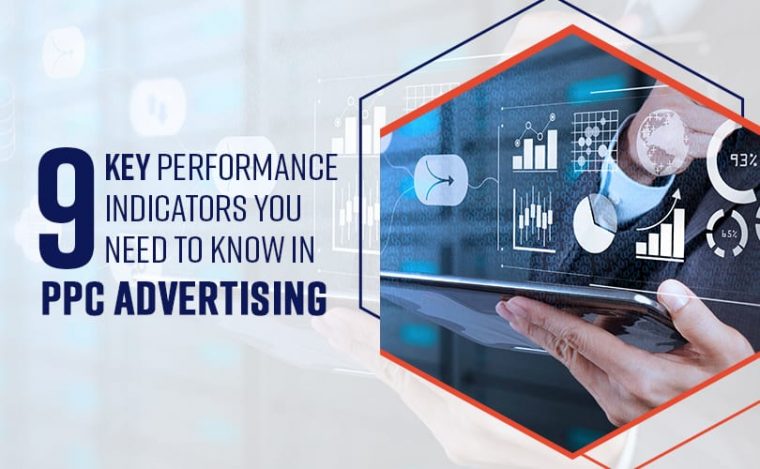Top 9 Key Performance Indicators You Need to Know in PPC Advertising

Do you feel overwhelmed from all the information you’ve been given regarding the PPC (Pay Per Click) metrics in your Google Ads account? An overload of information can be very confusing, so it’s important to remove any excess information and focus on the metrics that contribute value to the performance analysis for your PPC campaigns.
But what are these metrics and why is it so important to measure them?
Whether you’re running a campaign for an e-commerce business or a start-up business, your advertising goal should be to know what works and what will lead you in the right direction. You should keep track of the results from each campaign. In order for your PPC campaign to be successful, you should pay close attention to the KPIs (Key Performance Indicators).
Here are 10 of the most essential KPIs used to measure the performance of a campaign in PPC
1. Impressions
An impression is how often your ads are visible on search results pages or any PPC advertising platform.
While the impression metric may not be the most important KPI for a successful campaign, it is essential to know which sites your ads are visible on. The success of a PPC campaign also depends on the number of impressions you get that lead to clicks and conversions.
2. Clicks
KPI determines how many people click on your ad. These clicks are the key indicator of a successful PPC campaign as every conversion is only one click away.
The performance of a campaign is often measured with the number of clicks you receive. If there are no recorded clicks, you should consider making a few changes, such as increasing bids, changing keywords, etc.
While clicks are a great KPI on how your campaign is performing, they aren’t the sole measurement when it comes to the success of a campaign.
3. CTR
CTR, Click-Through Rate, is also one of the key components to measuring the success of a PPC campaign. CTR is measured by dividing the total number of clicks during your campaign by the total number of impressions.
A high CTR results in a high-quality score, which will ultimately help maintain your ads position on a search results page. Achieving a high CTR also shows that you are driving more people to your website or landing page.
4. CPA
Cost Per Acquisition, or Cost Per Conversion, also plays a very important role in measuring the success of a PPC campaign. CPA is defined as the price you will pay for every new lead during your campaign. This is measured by dividing the total amount spent during the campaign by the total number of conversions.
So, what is a good CPA and how much does it require you to spend on every new conversion? Every business has unique answers to these questions. And in order for you to determine a good CPA or maximum CPA for your business, you need to calculate the average revenue per lead or sale. CPA is a financial metric that calculates the revenue impact of your PPC campaign.
5. CPC
CPC, Cost Per Click, is the overall price you pay for each click during your campaign. It’s measured by dividing the total amount spent during your campaign by the total number of clicks you had.
Because of the way Google ads auction or most of the platform works, the cost per click will depend on how your competitors are bidding on a particular keyword or audience. Depending on the bidding strategy you use, you can set a maximum CPC for how much you want to pay for a click at the keyword level, ad group level, and campaign level.
6. Impression Share
Impression share provides a competitive insight for each campaign. It helps you better understand what percentage of sharing you receive compared to the competition. For example, in Google ads if you’re receiving 40% of the impression share for a keyword, your competitors are getting 60% of the share for that same keyword.
Impression share is measured by the number of impressions you’ve received divided by the eligible number of impressions in the search results. Eligible impressions are determined by various factors, such as targeted settings, quality, and approval status.
This data can be used to increase your impression share and minimize the amount of share your competitors are getting per keyword. You can increase your impression share by increasing your bids for certain keywords, or simply use a “Target Impression Share” bidding strategy.
7. Click Share
Similar to impression share, click share also provides you with direct competitive insight for your campaigns. For example, if you receive 60% of the clicks for a keyword, it’s estimated that there were 40% more clicks you could have received or that your competitor received the other 40%.
Click share is the estimated amount of shares you received during a campaign. This metric determines whether your campaign has the potential to capture more clicks or not.
This data can also be used to increase the number of potential clicks that your competitors receive by increasing bids, budgets, ad extensions, etc.
8. Quality Score
The quality score metric determines the quality and relevancy of your ad content. Your quality score will depend on several factors including past performance, CTR history, landing page experience, keyword relevance, and ad content relevancy.
Quality score plays an essential role in determining the position of your ad on search results pages. If you’re experiencing a high-qualityscore, it shows that your PPC ad is meeting potential customer requirements. This also leads to decreasing the CPC of your keywords because your ads and landing pages are meeting the needs of customers.
A good quality score is usually between 7 and 10, and also means that you are paying less money to advertise your campaign. A bad score is usually less than a 6 and means that you need to be paying more to get to the desired position.
9. Conversion Rate
Conversion rate is one of the most important indicators for the success of your PPC campaign. It’s the percentage of the people who visited your website and converted into a customer. This can be measured by dividing the total number of conversions by the total number of clicks your campaign received.
You can get a higher conversion rate by increasing your overall quality score and updating your landing page design to generate more leads.
Reporting KPI
KPIs play an essential role to determine the success of your PPC campaign. All the metrics are connected with each other. It is not necessary that one metrics solely can measure the success of your campaign.
That’s why you should focus on improving all the metrics, instead of focusing on one or two metrics only. You also should track and improve the metrics on a regular basis to make your PPC campaign successful.
We understand how difficult running a successful PPC campaign can be, especially when there is a lot of information available for different metrics. The key is to understand which metrics or KPIs are essential for your campaigns. Have more queries on how to run a successful PPC campaign? Don’t Worry, here at Cibirix – We have a team of Certified Professionals to help you running the successful PPC Campaigns. Call Now or Inquire Online at Cibirix Digital Marketing Agency to get the best solution.
About Author

Abhishek Yadav
Abhishek Yadav is a social media executive at Cibirix. His particular area of focus relates to boosting organic social media marketing for Cibirix clients. Abhishek follows all of the emerging trends with social media, and helps our clients to realize greater reach and engagement on all of their social media platforms. Thanks to his analytical skills and creative ideas, Abhishek is able to deliver positive results for our many social media clients. In his free time, Abhishek likes to play cricket. He also enjoys outings with friends and family. Abhishek is an avid traveler, is passionate about hiking and trekking in various locations, and also loves painting and cycling.


